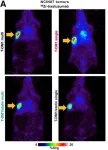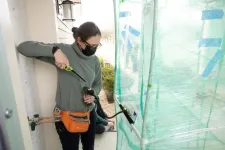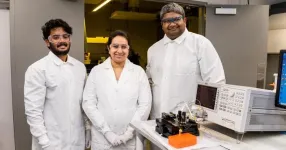(Press-News.org) Reston, VA—A novel therapeutic approach that combines human epidermal growth receptor factor 2 (HER2)-targeted therapies with the cholesterol-lowering drug lovastatin can reduce the number of cancer treatments required to prevent tumor growth. Monitored by immuno-PET scans, this combination therapy has the potential to personalize treatment for cancer patients and spare them from harmful side effects. This research was published in the October issue of The Journal of Nuclear Medicine.
Antibody-drug conjugates (ADCs) have become an eminent cancer treatment because of their ability to precisely target tumors with potent efficacy. HER2-ADC therapies have been effective in treating breast, lung, bladder, and stomach cancers. Although they are usually well-tolerated, multiple doses of the drugs can result in severe side effects, including low blood counts, liver damage, and lung damage. Strategies that reduce toxic side effects caused by ADCs and predictive biomarkers of ADC toxicity are currently an unmet clinical need.
“In this study, we sought to determine whether a single dose of HER2-ADCs could be administered in combination with lovastatin (which temporarily elevates cell-surface HER2) to achieve therapeutic efficacy similar to that of a multiple dose regime,” said Patricia Pereira, PhD, assistant professor at the Mallinckrodt Institute of Radiology at the Washington University School of Medicine in St. Louis, Missouri. “We also used HER2-targeted immuno-PET to monitor changes in HER2 expression after ADC therapy.”
Researchers injected mice with cultured gastric cancer cells and patient-derived gastric cancer cells. When tumors grew sufficiently, the mice were divided into groups and received various treatment schedules (no treatment, multiple doses of ADC, multiple doses of ADC with lovastatin, single dose of ADC, or single dose of ADC with lovastatin). Immuno-PET was used to investigate the dosing regimen and the efficacy of the treatment schedules.
A single dose of ADC therapy combined with lovastatin was found to reduce tumor volume at rates similar to those resulting from multiple doses of ADC in a preclinical setting. The study results showed that immuno-PET can noninvasively monitor HER2 tumor levels after treatment with HER2-targeted ADC therapies.
“This preclinical work is significant because it has the potential to improve therapy for patients with HER2-positive cancers,” noted Pereira. “It not only simplifies treatment by exploring single-dose schedules of antibody-drug conjugates but can also reduce side effects by minimizing the number of doses required. Additionally, it personalizes therapy using molecular imaging, enhancing treatment efficacy.”
She continued, “The findings suggest a future where molecular imaging techniques play a critical role in guiding drug development and cancer treatment decisions, particularly as various ADCs are being tested and approved for cancer treatment. Currently, there is no perfect way to select tumors or monitor their response to ADCs. This research indicates that molecular imaging can bridge this gap by providing real-time insights into therapy response.”
This study was made available online in June 2023.
The authors of “Immuno-PET Detects Antibody–Drug Potency on Coadministration with Statins” include Emma L. Brown, Shayla Shmuel, Sandeep Surendra Panikar, Na-Keysha Berry, and Patrícia M. R. Pereira, Department of Radiology, Mallinckrodt Institute of Radiology, Washington University School of Medicine, St. Louis, Missouri; Komal Mandleywala and Yi Rao, Department of Radiology, Memorial Sloan Kettering Cancer Center, New York, New York; Abbey Zidel, Department of Radiology, Mallinckrodt Institute of Radiology, Washington University School of Medicine, St. Louis, Missouri, and Department of Biology, Washington University School of Medicine, St. Louis, Missouri; and Jason S. Lewis, Department of Radiology, Memorial Sloan Kettering Cancer Center, New York, New York, Department of Pharmacology, Weill Cornell Medical College, New York, New York; Molecular Pharmacology Program, Memorial Sloan Kettering Cancer Center, New York, New York; Department of Radiology, Weill Cornell Medical College, New York, New York; and Radiochemistry and Molecular Imaging Probes Core, Memorial Sloan Kettering Cancer Center, New York, New York
Visit the JNM website for the latest research, and follow our new Twitter and Facebook pages @JournalofNucMed or follow us on LinkedIn.
###
Please visit the SNMMI Media Center for more information about molecular imaging and precision imaging. To schedule an interview with the researchers, please contact Rebecca Maxey at (703) 652-6772 or rmaxey@snmmi.org.
About JNM and the Society of Nuclear Medicine and Molecular Imaging
The Journal of Nuclear Medicine (JNM) is the world’s leading nuclear medicine, molecular imaging and theranostics journal, accessed 15 million times each year by practitioners around the globe, providing them with the information they need to advance this rapidly expanding field. Current and past issues of The Journal of Nuclear Medicine can be found online at http://jnm.snmjournals.org.
JNM is published by the Society of Nuclear Medicine and Molecular Imaging (SNMMI), an international scientific and medical organization dedicated to advancing nuclear medicine and molecular imaging—precision medicine that allows diagnosis and treatment to be tailored to individual patients in order to achieve the best possible outcomes. For more information, visit www.snmmi.org.
END
It can be a relief to scratch the occasional itch, but when itch gets out of control, it can become a serious health problem. How does the body know when to stop?
Scientists at UC San Francisco are getting close to an answer. In a breakthrough that could transform how doctors treat conditions from eczema to allergies, they have discovered a feedback loop centered on a single immune protein called IL-31 that both causes the urge to itch and dials back nearby inflammation.
The findings, published on October 13th in Science Immunology, lay the groundwork ...
Newly published research on indoor air quality from Colorado State University shows wildfire smoke may linger in homes long after the initial blaze has been put out or winds have shifted.
The findings, published in Science Advances, show that wildfire smoke can attach to home surfaces like carpet, drapes or counters – extending the exposure for those inside and potentially causing health problems even after an initial cleaning activity by air purifiers. However, Professor Delphine Farmer said the research also shows that simple surface cleaning – like ...
CAMBRIDGE, MA -- The genome of the SARS-CoV-2 virus encodes 29 proteins, one of which is an ion channel called E. This channel, which transports protons and calcium ions, induces infected cells to launch an inflammatory response that damages tissues and contributes to the symptoms of Covid-19.
MIT chemists have now discovered the structure of the “open” state of this channel, which allows ions to flow through. This structure, combined with the “closed” state structure that was reported by the same lab in 2020, could help scientists ...
LEXINGTON, Ky. (Oct. 11, 2023) — On Tuesday, Oct. 10, a ribbon-cutting ceremony signified the official opening of Kentucky Children’s Richmond Road, the new home of four pediatric specialty clinics. This facility will offer a continuum of care to infants, children and adolescents with complex medical and behavioral needs.
“The mission of Kentucky Children’s Hospital has always been to provide the most advanced, comprehensive care to our patients and their families without them having to travel far from home,” said Scottie B. Day, M.D., physician-in-chief ...
The second SELINA thematic workshop took place from 2-5 October 2023 in Madrid, Spain, hosted by SELINA’s partner Rey Juan Carlos University. This hybrid event with the theme "Advancing solutions" (for mapping, assessment and accounting of ecosystems and their services) brought together over 100 participants (15 of them online) from all 27 EU member states, Israel, Norway, the UK and Switzerland. Apart from the SELINA partners, the event was also attended by the SELINA Advisory Board members ...
LEXINGTON, Ky. (Oct. 11, 2023) — The University of Kentucky has been selected as the nationwide coordination center for a National Institutes of Health (NIH) initiative. Danelle Stevens-Watkins, Ph.D., will lead the National Institute on Drug Abuse (NIDA) Racial Equity Initiative as principal investigator. The project is supported by a $3.4 million, five-year NIDA grant.
The UK Racial Equity Initiative Coordinating Center will be a national resource for researchers receiving funding to address health disparities ...
Three faculty members at the Johns Hopkins University School of Medicine have been elected to the National Academy of Medicine (NAM), an independent organization made up of leading professionals from multiple fields, such as public health, medicine, and natural, social and behavioral sciences. NAM serves alongside the National Academy of Sciences and the National Academy of Engineering as advisors to the national and international science communities.
The announcement of 100 new members was made October 9.
New members elected to NAM are chosen by current ...
A team of investigators from the UCLA Jonsson Comprehensive Cancer Center and the UCLA School of Dentistry received a five-year $4.6 million grant from the National Cancer Institute to develop and improve liquid biopsy technologies for the early detection of lung cancer — the leading cause of cancer death in both men and women in the U.S.
UCLA is one of five institutions in the nation that is part of the NCI Liquid Biopsy Consortium that is designed to find a better way to detect early signs of lung cancer in people with ...
NJIT has secured a $6 million grant from the National Science Foundation (NSF) to translate science and engineering discoveries into market-ready technologies that will improve quality of life in areas ranging from health care, to sustainable energy, to data privacy.
Awarded by the agency’s Directorate for Technology, Innovation, and Partnerships, the grant will accelerate the development of promising prototypes and enable market validation and other commercialization activities. It will also strengthen the university’s entrepreneurial culture ...
BIRMINGHAM, Ala. – Fecal microbe transplants from healthy donors can treat patients with recurrent Clostridium difficile infections. However, after tens of thousands transplants, little was known about which donor strains provide long-term engraftment, and which engraft early after the transplant. Most failures of fecal microbe transplantation occur in the first four weeks.
Recurrent C. difficile infections occur after suppressive antibiotic treatments that knock out almost all of the normal gut flora. Patients suffer watery diarrhea, painful abdominal cramps, a feeling of sickness, fevers and weight loss.
In 2021, researchers at the Icahn ...









